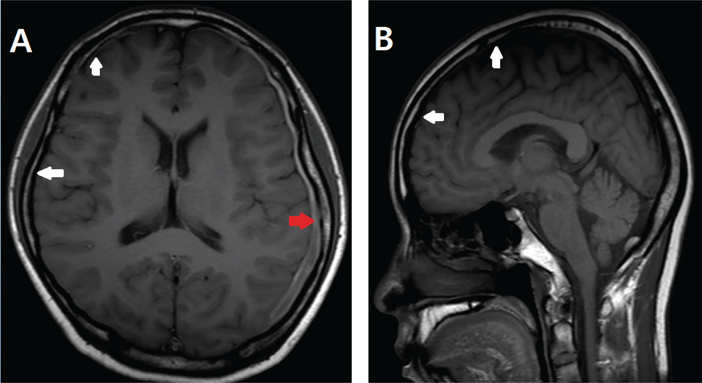J Dent Anesth Pain Med.
2018 Aug;18(4):255-259. 10.17245/jdapm.2018.18.4.255.
Epidural blood patch treatment of diplopia that developed after headache resolution in a patient with spontaneous intracranial hypotension
- Affiliations
-
- 1Department of Anesthesiology and Pain Medicine, Asan Medical Center, University of Ulsan College of Medicine, Seoul, Korea. choiss@amc.seoul.kr
- KMID: 2419067
- DOI: http://doi.org/10.17245/jdapm.2018.18.4.255
Abstract
- Sudden headache onset may rarely be caused by spontaneous intracranial hypotension (SIH). Other associated symptoms in patients with SIH are nausea, vomiting, vertigo, hearing alteration, and visual disturbance. This case report describes a 43-year-old female diagnosed with SIH who developed diplopia after resolution of an abrupt-onset headache, which was managed with conservative treatments, including bed rest and hydration. She was also diagnosed with secondary right sixth cranial nerve palsy. Although conservative management relieved her headache, the diplopia was not fully relieved. Application of an autologous epidural blood patch successfully relieved her diplopia, even after 14 days from the onset of visual impairment.
MeSH Terms
Figure
Reference
-
1. Schievink WI. Spontaneous spinal cerebrospinal fluid leaks. Cephalalgia. 2008; 28:1345–1356.
Article2. Paldino M, Mogilner AY, Tenner MS. Intracranial hypotension syndrome: a comprehensive review. Neurosurg Focus. 2003; 15:ECP2.
Article3. Schievink WI. Spontaneous spinal cerebrospinal fluid leaks and intracranial hypotension. JAMA. 2006; 295:2286–2296.
Article4. Zada G, Solomon TC, Giannotta SL. A review of ocular manifestations in intracranial hypotension. Neurosurg Focus. 2007; 23:E8.
Article5. Kim YA, Yoon DM, Yoon KB. Epidural Blood Patch for the Treatment of Abducens Nerve Palsy due to Spontaneous Intracranial Hypotension - A Case Report. Korean J Pain. 2012; 25:112–115.
Article6. Berroir S, Loisel B, Ducros A, Boukobza M, Tzourio C, Valade D, et al. Early epidural blood patch in spontaneous intracranial hypotension. Neurology. 2004; 63:1950–1951.
Article7. Sencakova D, Mokri B, McClelland RL. The efficacy of epidural blood patch in spontaneous CSF leaks. Neurology. 2001; 57:1921–1923.
Article8. Ko HC, Jung JK, Moon HS, Song JH, Eum SH, Cha YD. Treatment of spontaneous intracranial hypotension with multiple leakage sites of cerebrospinal fluid : A case report. Anesth Pain Med. 2008; 3:330–333.9. Kong DS, Park K, Nam DH, Lee JI, Kim ES, Kim JS, et al. Atypical spontaneous intracranial hypotension (SIH) with nonorthostatic headache. Headache. 2007; 47:199–203.
Article10. Schievink WI, Maya MM, Louy C, Moser FG, Tourje J. Diagnostic criteria for spontaneous spinal CSF leaks and intracranial hypotension. AJNR Am J Neuroradiol. 2008; 29:853–856.
Article11. Schievink WI, Louy C. Precipitating factors of spontaneous spinal CSF leaks and intracranial hypotension. Neurology. 2007; 69:700–702.
Article12. Mokri B, Maher CO, Sencakova D. Spontaneous CSF leaks: underlying disorder of connective tissue. Neurology. 2002; 58:814–816.
Article13. Béchard P, Perron G, Larochelle D, Lacroix M, Labourdette A, Dolbec P. Case report: epidural blood patch in the treatment of abducens palsy after a dural puncture. Can J Anaesth. 2007; 54:146–150.
Article14. Khemka S, Mearza AA. Isolated sixth nerve palsy secondary to spontaneous intracranial hypotension. Eur J Neurol. 2006; 13:1264–1265.
Article15. Russo A, Tessitore A, Cirillo M, Giordano A, De Micco R, Bussone G, et al. A transient third cranial nerve palsy as presenting sign of spontaneous intracranial hypotension. J Headache Pain. 2011; 12:493–496.
Article
- Full Text Links
- Actions
-
Cited
- CITED
-
- Close
- Share
- Similar articles
-
- Intracranial Hypertension Following Epidural Blood Patch in a Patient With Spontaneous Intracranial Hypotension
- A Case of Spontaneous Intracranial Hypotension with Headache and Tinnitus Treated with Epidural Blood Patch : A Case Report
- A Case Report of Spontaneous Intracranial Hypotension Treated with Cervical Epidural Blood Patch
- Epidural Blood Patch in Patient with Spontaneous Intracranial Hypotension: A case report
- Epidural Blood Patch to Treat Spontaneous Intracranial Hypotension




